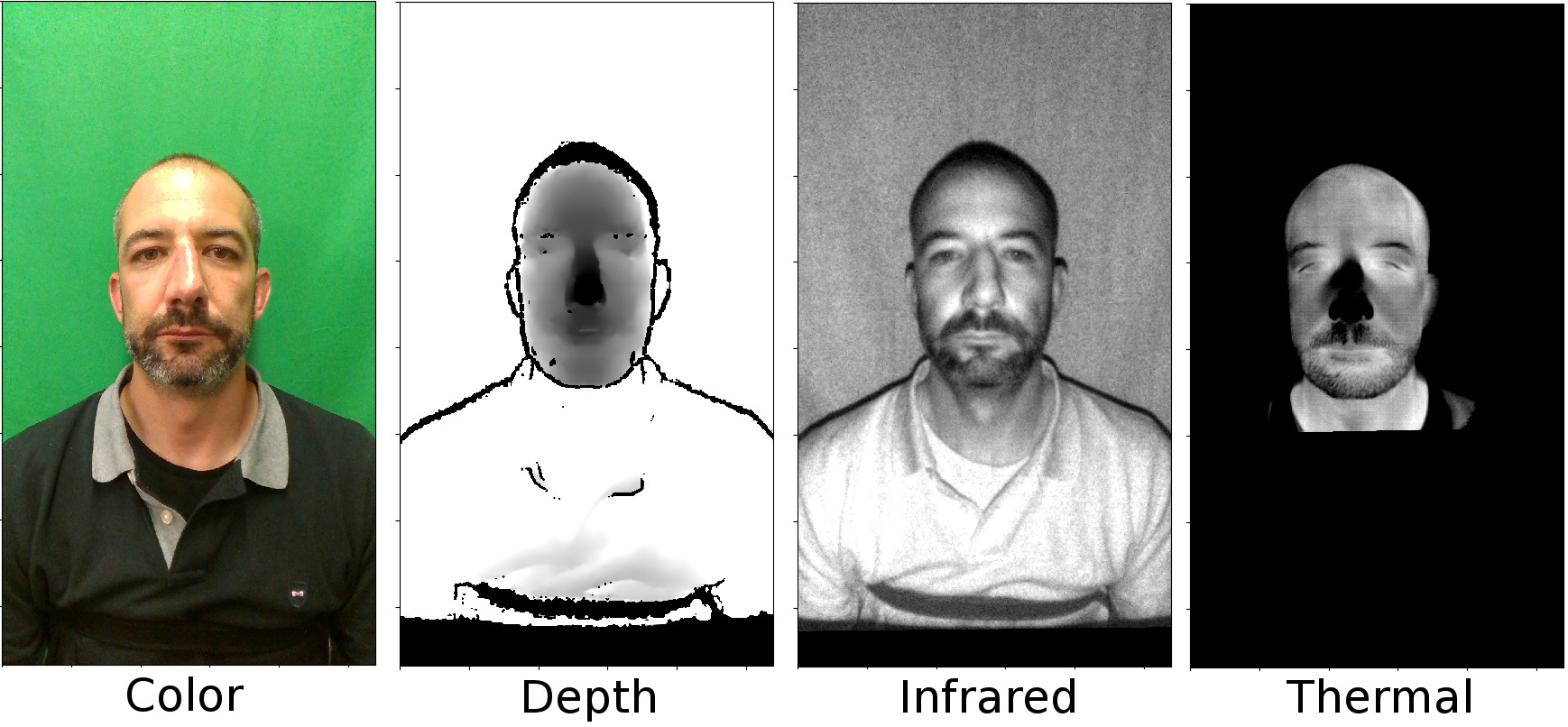Computer Vision and Deep Learning for Biometrics
Posted on Tue 01 May 2018 in research

Sample from the WMCA Dataset of bonafide accesses for the four acquisition channels after alignment. The images from all channels are aligned with the calibration parameters and normalized to eight bits for better visualization.
I worked with various different themes in computer vision applied to biometric recognition. In here, I highlight some of the more recent contributions:
- Presentation Attack Detection (PAD): Biometric recognition systems are exposed to presentation attacks, and dectectors for this purpose are required building blocks of thrustworthy systems. Most PAD systems work discriminatively, trying to separate attacks from bona fide presentations. We showed this technique does not generalize well to unseen presentation attacks. We explored, for the first time, alternate approaches by joint-modelling client identity as a way to calibrate PAD output scores (Chingovska and Anjos, 2015), showing increased robustness to unseen attacks. More recently, we also showed that solely modelling bona fide presentations is also an effective way to increased PAD robustness (Nikisins et al., 2018). Finally, we showed that by adding heterogenous inputs to PAD systems can improve their robustness (George et al., 2019) to achieve state-of-the-art performance, even to unseen conditions during training.
- Domain Specific Units (Adaptation): In (dFreitasPereira et al., 2019), we apply domain adaptation via dedicated Domain-Specific Units (DSU), with an application to Heterogeneous Face Recognition. In this class of problems, one wants to recognize an individual across different spectral data, based on the representation on a principal spectrum (e.g., visual). It is a challenging task because multi-spectral data for covering large populations is rare, which in turn stymies the training of deep convolution-based architectures for this task. We developed a mechanism to adapt the parameters of models pre-trained on large visual spectral face recognition datasets, which are readily available. My contributions are directly related to core idea of this work.
Reproducibility Checklist
- All published papers are 100% reproducible
- Software is open-source, extensible and tested on a regular basis
- Complete documentation is available
- For details on each publication, check the publication directly.
Datasets
Some of the datasets published during this period:
- WMCA "Wide Multi Channel Presentation Attack" Database, DOI: 10.34777/8zdh-v182
- Replay Attack Database, DOI: 10.34777/cwcg-7r82
- COHFACE Database, DOI: 10.34777/ff3f-ba56
Partnership
Work in Biometrics was conducted on the context of various SNSF, EU FP7, IARPA, and Innosuisse projects together with the Biometrics Security & Privacy Group at Idiap.
The ensemble of this work was published as book chapters, international peer-reviewed scientific journals (including articles at very high-impact factor journals) and in peer-reviewed conference papers totalling a few thousand citations.
Bibliography
Ivana Chingovska and André Anjos. On the use of client identity information for face anti-spoofing. IEEE Transactions on Information Forensics and Security, Special Issue on Biometric Anti-spoofing, 10(4):787–796, 2 2015. doi:10.1109/TIFS.2015.2400392. ↩
Tiago de Freitas Pereira, André Anjos, and Sébastien Marcel. Heterogeneous face recognition using domain specific units. IEEE Transactions on Information Forensics and Security, 12 2019. URL: https://publications.idiap.ch/index.php/publications/show/3963, doi:10.1109/TIFS.2018.2885284. ↩
Anjith George, Zohreh Mostaani, David Geissenbuhler, Olegs Nikisins, André Anjos, and Sébastien Marcel. Biometric face presentation attack detection with multi-channel convolutional neural network. IEEE Transactions on Information Forensics and Security, 5 2019. doi:10.1109/TIFS.2019.2916652. ↩
Olegs Nikisins, Amir Mohammadi, André Anjos, and Sébastien Marcel. On effectiveness of anomaly detection approaches against unseen presentation attacks in face anti-spoofing. In The 11th IAPR International Conference on Biometrics (ICB 2018). February 2018. URL: https://publications.idiap.ch/index.php/publications/show/3793, doi:10.1109/ICB2018.2018.00022. ↩